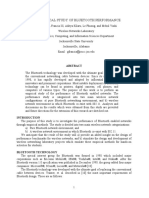Bluetooth and LRC
Bluetooth and LRC
Uploaded by
api-341314632Copyright:
Available Formats
Bluetooth and LRC
Bluetooth and LRC
Uploaded by
api-341314632Original Title
Copyright
Available Formats
Share this document
Did you find this document useful?
Is this content inappropriate?
Copyright:
Available Formats
Bluetooth and LRC
Bluetooth and LRC
Uploaded by
api-341314632Copyright:
Available Formats
Report of a wireless communication and
protocols for the Robot Challenge approach via
Bluetooth
By Lukas Miltenis
In our Lego Robot Challenge project, we were given the opportunity to
utilise Bluetooth as a means of communicating and controlling our robot.
Bluetooth is defined as: a standard for the short-range wireless
interconnection of mobile phones, computers, and other electronic
devices. by the Oxford Dictionaries (Definition of Bluetooth, 2016). It is a secure
means of wireless communication, which operates in the 2.4GHz radio
band and is perfect for short-range, low-cost and power transmissions up
to 10 metres (on the EV3 brick) or even 100 metres on different hardware
(Bluetooth Basics, 2016)
. Bluetooth networks are called piconets, and use a
master/slave model to control the devices that send and receive data. The
master coordinates communication through the Bluetooth network, it
sends data to its slaves and requests data from them as well. Slaves can
only communicate with their master (Bluetooth Basics, 2016). By agreement, the
master and slave can switch roles if needed.
We intended to use this feature as a means of starting and stopping our
program at any given time without the need of physical interaction with
the robot. To accomplish this we would use special software for our
Android phones (EV3 Mailbox Remote), which lets us send messages to
the EV3 brick. This software would establish a connection with our EV3
brick and send messages into its Bluetooth mailbox, which would then
decide whether to stop or start the program depending on the
received message. Because the Android software and the EV3 brick follow
the Bluetooth protocol stack they could interact with each other via the
Logical Link Control and Adaption Protocol (L2CAP), which is used for the
segmentation and reassembly of on-air packets (List of Bluetooth protocols 2016).
The main difference between other wireless networking (such as Wireless
LAN) and Bluetooth networking are: Bluetooth has lower range, has a
lower maximum radio band (802.11a WLAN is up to 5GHz), is considerably
slower. Bluetooth also uses less power than WLAN devices resulting in less
drain on battery, is cheaper to produce and implement. Both address
different wireless connectivity requirements (Competition or Complimentary n.d.). WLANs
and LANs in general use IP addresses to communicate between each
device on the network.
In conclusion, our team did not fully utilise Bluetooth in our project.
However if we were to, the use of wireless communication would have
increased the complexity of our project, while giving us an easier time of
issuing commands to the robot.
List of References
Bluetooth 2016, Bluetooth Wikipedia [online] available from
<https://en.wikipedia.org/wiki/Bluetooth> [7 December 2016]
Bluetooth Basics 2016, Bluetooth Basics - learn.sparkfun.com [online]
available from <https://learn.sparkfun.com/tutorials/bluetooth-basics> [7
December 2016]
Competition or Complimentary n.d., Bluetooth versus Wireless LANs
Competition or Complimentary [online] available from
<http://www.mobileinfo.com/Bluetooth/Bluetooth-vs-WLAN.htm> [7
December 2016]
Definition of Bluetooth 2016, Bluetooth definition of Bluetooth in English
| Oxford Dictionaries [online] available from
<https://en.oxforddictionaries.com/definition/Bluetooth> [7 December
2016]
List of Bluetooth protocols 2016, List of Bluetooth protocols Wikipedia
[online] available from
<https://en.wikipedia.org/wiki/List_of_Bluetooth_protocols> [7 December
2016]
You might also like
- Practical Electrical Engineering (PDFDrive)Document673 pagesPractical Electrical Engineering (PDFDrive)zeromeans100% (13)
- SIGMA Optimization Pro Instruction ManualDocument24 pagesSIGMA Optimization Pro Instruction ManualjuanjulianjimenezNo ratings yet
- MSCDocument2 pagesMSCMARIYAM NAVED0% (1)
- Messaging Bluetooth For Your Future .Document14 pagesMessaging Bluetooth For Your Future .vkylovekumarNo ratings yet
- BluetoothDocument2 pagesBluetoothapi-297074626No ratings yet
- Bluetooth IntroductionDocument4 pagesBluetooth IntroductiongowdamandaviNo ratings yet
- Bluetooth Technology: Mobile ComputingDocument12 pagesBluetooth Technology: Mobile Computingrws1000No ratings yet
- Bluetooth PiconetDocument25 pagesBluetooth PiconetAbhishek SkNo ratings yet
- Bluetooth Is A TechnologyDocument7 pagesBluetooth Is A TechnologyChandan DattaNo ratings yet
- Wimax Vs Bluetooth (Leah)Document7 pagesWimax Vs Bluetooth (Leah)nicholo_yupi20No ratings yet
- Bluetooth TechnologyDocument13 pagesBluetooth TechnologyParthasarathi AnbalaganNo ratings yet
- Bluetooth Technology RajanDocument3 pagesBluetooth Technology RajanKandibanda NithinNo ratings yet
- The Bluetooth TechnologyDocument8 pagesThe Bluetooth TechnologyKushal DeyNo ratings yet
- Video Over Wireless Bluetooth™ Technology: Ben SmithDocument9 pagesVideo Over Wireless Bluetooth™ Technology: Ben SmithSubhash vetchaNo ratings yet
- A Survey On Bluetooth TechnologyDocument22 pagesA Survey On Bluetooth TechnologytarasmartinNo ratings yet
- Bluetooth - One of The Best WPAN Solutions For Bridging PAN and Wider Networks?Document4 pagesBluetooth - One of The Best WPAN Solutions For Bridging PAN and Wider Networks?Victor PassosNo ratings yet
- BluetoothDocument3 pagesBluetoothSahil KocharNo ratings yet
- Bluetooth: Author: Asharani P. Mirazkar Vijaylaxmi A. HorakeriDocument7 pagesBluetooth: Author: Asharani P. Mirazkar Vijaylaxmi A. Horakeriapi-19799369No ratings yet
- An Empirical Study of Bluetooth PerformanceDocument11 pagesAn Empirical Study of Bluetooth PerformanceGuillermo FranciaNo ratings yet
- Bluetooth: ObjectiveDocument8 pagesBluetooth: ObjectivePradeepCoolNo ratings yet
- The Bluetooth TechnologyDocument8 pagesThe Bluetooth TechnologyKrunal PatelNo ratings yet
- BluetoothDocument12 pagesBluetoothለዛ ፍቅርNo ratings yet
- Bluetooth: Name and LogoDocument7 pagesBluetooth: Name and LogoRey HeyNo ratings yet
- Bluetooth Technology in Wireless CommunicationsDocument12 pagesBluetooth Technology in Wireless CommunicationsLiliana AmpNo ratings yet
- Bluetooth: Name and LogoDocument11 pagesBluetooth: Name and LogoSatish KumarNo ratings yet
- Blue Toot 1Document25 pagesBlue Toot 1shanin2006No ratings yet
- "MMMM #M: MM M M MM M!Document21 pages"MMMM #M: MM M M MM M!waqaskhattakNo ratings yet
- Bluetooth: Seminar Report ForDocument16 pagesBluetooth: Seminar Report FortravelnagaNo ratings yet
- Understanding BluetoothDocument12 pagesUnderstanding BluetoothAntonello StellaNo ratings yet
- BluetoothDocument27 pagesBluetoothshanty85No ratings yet
- Se BL TeppDocument25 pagesSe BL TeppmadhukarNo ratings yet
- BluetoothDocument8 pagesBluetoothGouse111No ratings yet
- Chapter 13. Bluetooth TechnologyDocument10 pagesChapter 13. Bluetooth TechnologySenthilvelan MuruganNo ratings yet
- Authenticated Data Scrambler and Descrambler For Advanced Bluetooth DevicesDocument4 pagesAuthenticated Data Scrambler and Descrambler For Advanced Bluetooth DevicesijaertNo ratings yet
- Ô PPPPPPPPPPPPPPPPP PPPPPPPPPPPPPPPPPPPPPPPPPPPPPPPPPPPPPPPPPDocument31 pagesÔ PPPPPPPPPPPPPPPPP PPPPPPPPPPPPPPPPPPPPPPPPPPPPPPPPPPPPPPPPPJoshua KurianNo ratings yet
- Final Project Data Communication and NetworksDocument19 pagesFinal Project Data Communication and NetworksjanshairkhanNo ratings yet
- Bluetooth Technology: A Global Specification For Wireless ConnectivityDocument7 pagesBluetooth Technology: A Global Specification For Wireless ConnectivityvenkateshmukharjiNo ratings yet
- 3modern Communication Techniques-BluetoothDocument10 pages3modern Communication Techniques-BluetoothchiyaseshuNo ratings yet
- ThesisDocument8 pagesThesishalasilili99No ratings yet
- Bluetooth Technology: Presented ByDocument36 pagesBluetooth Technology: Presented Byhoney3590No ratings yet
- Seminar On: BluetoothDocument18 pagesSeminar On: BluetoothSriram ramsNo ratings yet
- Wa0001.Document31 pagesWa0001.DevarajNo ratings yet
- Presentation On Bluetooth TechnologyDocument19 pagesPresentation On Bluetooth TechnologySolanki Bhowmick92% (13)
- Experiment No 3Document5 pagesExperiment No 3Priti RumaoNo ratings yet
- Literature Review Bluetooth TechnologyDocument8 pagesLiterature Review Bluetooth Technologyafduadaza100% (1)
- B644 MC Exp-9Document4 pagesB644 MC Exp-9Aman SharmaNo ratings yet
- Bluetooth Wireless Technology: An: Datapro SummaryDocument15 pagesBluetooth Wireless Technology: An: Datapro SummaryKancham Srikanth ReddyNo ratings yet
- Bluetooth: Bluetooth Is A ProprietaryDocument31 pagesBluetooth: Bluetooth Is A ProprietaryAbdul BasithNo ratings yet
- 17b91a0539 SeminarDocument15 pages17b91a0539 Seminarkrishnasri ghantasala145No ratings yet
- A Comparative Study of Wireless Protocols: Bluetooth, Uwb, Zigbee, and Wi-FiDocument8 pagesA Comparative Study of Wireless Protocols: Bluetooth, Uwb, Zigbee, and Wi-FiAnonymous oTrMzaNo ratings yet
- Blue ToothDocument46 pagesBlue ToothKkkkNo ratings yet
- What Is BluetoothDocument4 pagesWhat Is BluetoothArpit SrivastavaNo ratings yet
- DCC MicroprojectDocument7 pagesDCC MicroprojectAbhishek GayakwadNo ratings yet
- Bluetooth TPPDocument4 pagesBluetooth TPPMangesh MahadikNo ratings yet
- What Is BluetoothDocument32 pagesWhat Is BluetoothHeni Jayanti SutadiNo ratings yet
- Assignment On Bluetooth TechnologyDocument16 pagesAssignment On Bluetooth TechnologyDeep DoradlaNo ratings yet
- WMN ProjectDocument16 pagesWMN ProjectIFAnupma JadhavNo ratings yet
- The Bluetooth SystemDocument16 pagesThe Bluetooth Systemy.priyankareddy7661No ratings yet
- G.P. Presentation ON: "Bluetooth"Document21 pagesG.P. Presentation ON: "Bluetooth"deepakbajajNo ratings yet
- BluetoothDocument14 pagesBluetoothSuriyaa SugumarNo ratings yet
- Analysis of A New Fifth-Order Boost ConverterDocument5 pagesAnalysis of A New Fifth-Order Boost ConverterHorderlin RoblesNo ratings yet
- 320D Electric SchematicDocument16 pages320D Electric SchematicOecox Cah Djadoel100% (2)
- Power Your Signal: Antenna SpecificationsDocument3 pagesPower Your Signal: Antenna SpecificationsMariNo ratings yet
- 212 PTM05 Electrical Power SystemsDocument31 pages212 PTM05 Electrical Power SystemsMuktasid Sakib RahmanNo ratings yet
- Rolling Element Bearing ProblemDocument2 pagesRolling Element Bearing ProblemAnibal QuezadaNo ratings yet
- 11 Television in GermanyDocument10 pages11 Television in GermanyMilena ŠmigićNo ratings yet
- P66 Series Electronic Fan Speed Controls: Product BulletinDocument7 pagesP66 Series Electronic Fan Speed Controls: Product BulletinAlejandro AvilaNo ratings yet
- 2018 Winter Question Paper (Msbte Study Resources)Document4 pages2018 Winter Question Paper (Msbte Study Resources)Parth patkarNo ratings yet
- MODU Part 6 E-Apr17 PDFDocument94 pagesMODU Part 6 E-Apr17 PDFValentina AntohiNo ratings yet
- Kendeil PDFDocument7 pagesKendeil PDFBrunophb2012No ratings yet
- Access Control - Conduit From Direct ACPDocument1 pageAccess Control - Conduit From Direct ACPAnonymous XYAPaxjbYNo ratings yet
- Ando AQ6317B - Optical Spectrum Analyzer PDFDocument4 pagesAndo AQ6317B - Optical Spectrum Analyzer PDFchaparalNo ratings yet
- Cd5e241 s1Document22 pagesCd5e241 s1Steven NgNo ratings yet
- Iball Decibel Android Alexa UserManualSetup v1 PDFDocument7 pagesIball Decibel Android Alexa UserManualSetup v1 PDFVyrax FalconNo ratings yet
- Abstract of Sniffer For Lost Mobiles123Document2 pagesAbstract of Sniffer For Lost Mobiles123Rnv Durga BhavaniNo ratings yet
- Adjustments - 2: Villa Sistemi Medicali ARCOVIS 2000 R - Adjustments - 2Document28 pagesAdjustments - 2: Villa Sistemi Medicali ARCOVIS 2000 R - Adjustments - 2mrscribd100% (1)
- 3 LED Battery Monitor CircuitDocument1 page3 LED Battery Monitor Circuittim schroderNo ratings yet
- Lab 2 ElectronicsDocument3 pagesLab 2 ElectronicsKaya EmanuelNo ratings yet
- Panel Boe Hv320wxc-100 0 (DS)Document27 pagesPanel Boe Hv320wxc-100 0 (DS)Milorad PajovicNo ratings yet
- Microcontrollers Notes For IV Sem ECE StudentsDocument19 pagesMicrocontrollers Notes For IV Sem ECE StudentsVigneshwar DhamodharanNo ratings yet
- Kruss Techdata k100 en PDFDocument4 pagesKruss Techdata k100 en PDFTravis HNo ratings yet
- BK1198 Datasheet EnglishDocument28 pagesBK1198 Datasheet EnglishMaria Aparecida100% (2)
- Automotive Infotainment GuideDocument32 pagesAutomotive Infotainment GuideDavid Fernández VillanuevaNo ratings yet
- Textbook - Primary and Secondary Cell and Corrosion Q'sDocument2 pagesTextbook - Primary and Secondary Cell and Corrosion Q'sBookAddict721No ratings yet
- FinalExam B AnsKeyDocument12 pagesFinalExam B AnsKeyDVRaoNo ratings yet
- Geafolproduct EnglishDocument4 pagesGeafolproduct EnglishkostyaNo ratings yet
- MCTR - Multi Carrier TranceiverDocument3 pagesMCTR - Multi Carrier TranceiverMarcelo100% (1)

























































































